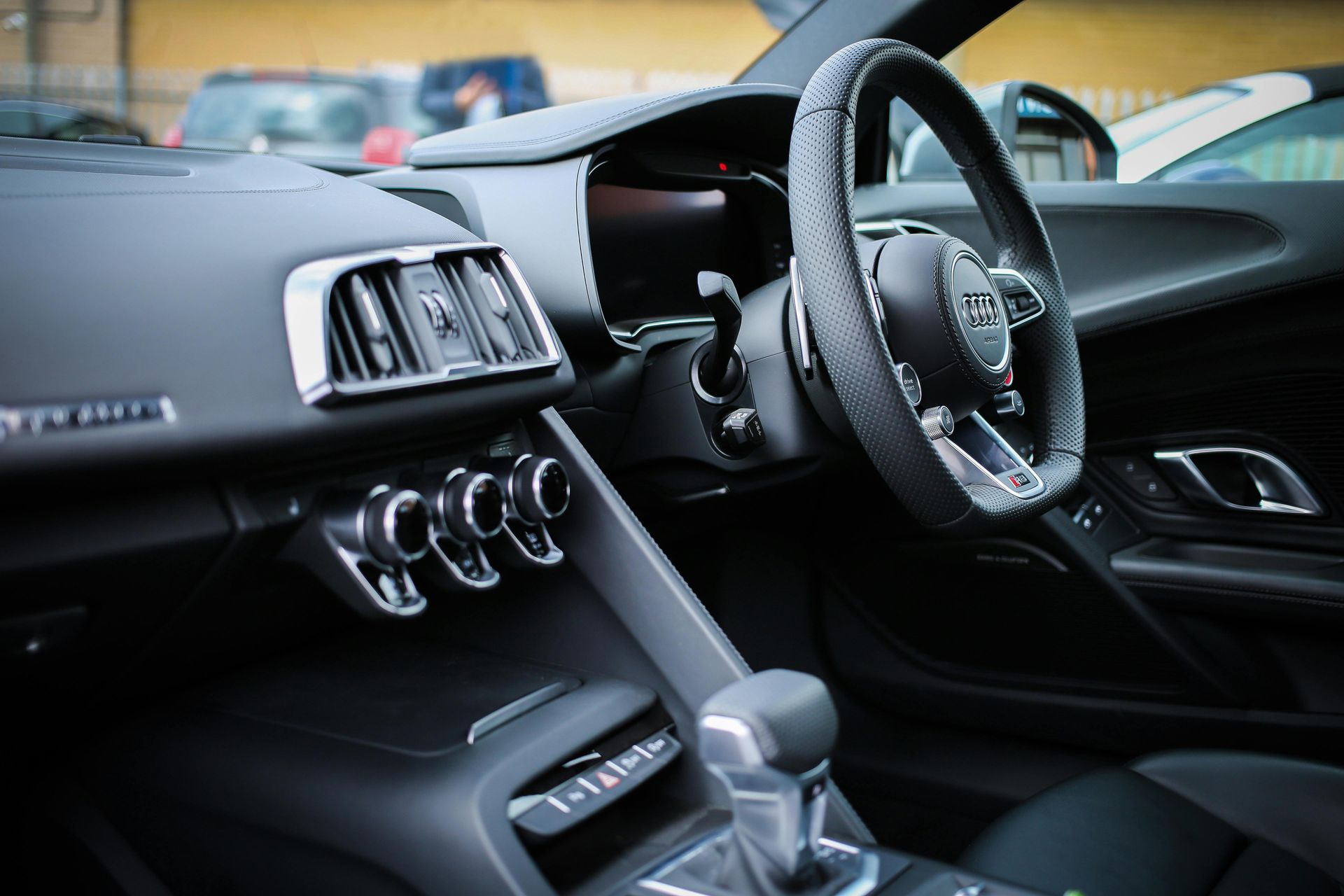How To Remove Stains From Your Car Interior (Complete Guide)
Wondering how to remove stains from a car? Spilled coffee, grease-stained food, dirty shoes left on the floor, or pet mishaps are common woes. Stains not only make things less comfortable; they lower your car's resale value, too.
In this in-depth guide, you will get do-it-yourself stain removal advice, when a professional is needed, as well as how you can avoid stains in the future. It's now time to get a like-new shine back on your car interior.

Key Takeaways
- Vacuum first and test cleaners in hidden spots before applying.
- Use DIY cleaners like vinegar, baking soda, club soda, or diluted detergent for affordable solutions.
- Call professionals for deep stains or detailing needs like steam cleaning and protective coatings.
- Match cleaners to material type: Fabric, leather, vinyl, or carpet.
- Prevent stains with protective products and regular maintenance.
Why Do Car Seats And Interiors Get Stained?
Regular use leads to common stains - coffee, food, grease, even ink or pet messes. Dirt and smells accumulate rapidly if you do not clean frequently.
Not vacuuming or maintaining the carpets will do more harm than good. After a while, seats and mats deteriorate further, while spots prove more difficult to clean. That's why the cycle of clean, protect, and restore will help maintain your interior looking fresh and long-lasting.
>>
Learn more about the
benefits of auto detailing.
How To Prepare Your Car Before Removing Stains
Before you start treating any stains, a little prep work goes a long way. Cleaning a dirty surface without preparation can actually spread the mess or damage the materials. Here's how to get your car interior ready:
- Vacuum Thoroughly: Remove any loose dirt, crumbs, or pet hair from the seats, carpets, and floor mats. This prevents debris from getting rubbed into the fabric while you clean.
- Wipe Down Hard Surfaces: Clean dashboards, door panels, and windows. A tidy interior gives you a clearer view of what needs attention and helps prevent dust from resettling.
- Test Your Cleaner: Always try any new cleaning solution on a hidden spot first to make sure it won’t stain or discolor the material.
- Blot, Don’t Scrub: When you’re ready to treat stains, gently blot them instead of scrubbing. Scrubbing too hard can damage delicate materials like fabric and leather.
This prep routine gives you the best shot at safely and effectively removing stains without causing more problems.
DIY Remedies To Remove Car Interior Stains
Wondering how to remove stains from a car without spending a fortune? Consider these tried-and-tested DIY methods that can help. These solutions are simple, affordable, and work well for everyday messes.
1. Vinegar And Water (Only Use For Fabric Seats)
Mix equal parts of white vinegar and water in a spray bottle. Lightly mist the stained area, then blot, not scrub, with a clean cloth. Let it air dry completely.
* Tip: Avoid using this on leather, it can dry out or damage the surface. If there’s a strong vinegar smell, just run your heater or AC for a few minutes.
2. Baking Soda Paste (Great For Floor Mats & Stubborn Spots)
Combine baking soda with just enough water to create a paste. Apply it to the stained area, gently work it in with a soft brush or cloth, then rinse and lightly shampoo if needed.
* Bonus: It also helps neutralize odors, especially from food or pet accidents.
3. Club Soda (Works Best On Fresh Spills)
For new spills, act quickly. Pour a small amount of club soda onto the spot, blot with a microfiber towel, and repeat until the stain lifts. Once it’s dry, vacuum to finish.
* Tip: Best for fabric and cloth seats, skip this one for leather or vinyl.
4. Mild Laundry Detergent Solution
Mix a teaspoon of gentle laundry detergent into warm water. Dampen a cloth with the solution (don’t soak it), blot the stain, then rinse with clean water and pat dry.
* Note: Make sure to remove all residue to avoid sticky spots or fabric damage.
>> Want to learn how to detail your car interior like a pro? Here's a full breakdown.
When Should You Call Professional Car Detailing Services?
DIY cleaning works for surface stains, but some stains won’t budge. That’s when it’s worth calling the pros.
Professional car detailing packages often include deep cleaning:
- Upholstery shampooing
- Steam cleaning
- Protective coatings
Detailers may also apply extras like ceramic coating or UV protectants, extending your interior’s life and keeping the surface stain-resistant.
Pro Tip: Professionals have tools that go beyond surface cleaning and help preserve your car’s resale value.
What Store-Bought Cleaners Work Best?
- Select car-grade upholstery or leather cleaners (do not use common household sprays).
- Look for EPA-approved, interior-safe options.
- Use in conjunction with a professional detailing or car wash appointment for optimal effect.
Do Steam And Enzyme Cleaners Work For Deep Stains?
Yes! Both are great on stink or stubborn spots:
- The enzyme cleaners dissolve organic spills such as food, pet incident, or coffee.
- Steam cleaning loosens grime, making shampooing more effective.
Use caution; hot or heavy pressure can mar some finishes.
How To Clean Different Types of Car Seats and Stains
Different stains need different approaches, and the surface you're cleaning makes all the difference. Here's how to treat common car interior stains based on seat material and mess type:
Cloth And Fabric Seats
Start by vacuuming thoroughly in order to remove dust particles and dirt. Then use a fabric-safe shampoo or a weak detergent. Gently work with a soft brush, then air-dry the seats without any musty odors or mold growing on them.
* Note: It's always a good idea to spot-test first so that you can make sure that the fabric will not fade or color change.
Leather & Vinyl Seats
Clean surfaces with a pH-balanced leather or vinyl cleaner. Afterward, condition the area with a top-grade leather conditioner to maintain a supple, non-crazing surface. To further protect the area, top it off with a UV-block coating or ceramic sealant.
* Tip: Avoid anything alcohol-based, it can dry out leather over time.
Coffee & Beverage Spills
Act fast. Blot the area with a clean towel to soak up as much liquid as possible. Then treat the spot with a vinegar-water spray or a bit of baking soda paste. Follow up with a light shampoo to break down any sugar that could attract dirt later.
Ink Stains
Use rubbing alcohol very sparingly, dab it on a cotton swab and gently blot the ink. Always test in a hidden area first. If needed, follow up with a mild degreaser to lift any remaining pigment.
Grease & Oil Stains
Sprinkle baking soda or cornstarch over the affected area to absorb excess oil. Let it sit for 10–15 minutes, then vacuum it up. Apply a fabric-safe degreaser and finish with a shampoo to restore the texture.
Pet Accidents & Organic Stains
These stains can linger if not handled properly. Start with an enzyme-based cleaner to break down the mess and neutralize odors at the source. Once clean, apply an odor-eliminating spray to freshen the area.
Aftercare & Prevention: Keeping Your Car Spotless
Learning how to remove stains from your car is only half the battle, the hard part is keeping them from coming back. Here's how you can stay one step ahead of the mess:
- Vacuum weekly if you can, so that dirt doesn't get deep into the fibers.
- Shampoo your seats and carpets every 2–3 months in order to remove light stains before they become permanent.
- Apply fabric protectants, UV blocking treatments, or ceramic finishes to help protect against future spills, fading, or sunlight damage.
- You don't want to miss professional detailing, a deep clean every few months keeps that showroom-new look and holds your car's resale value.
Taking these steps not only makes it more rewarding for you to own a car, but it also saves you time, effort, and money in the long term as well.
>> Check out our essential paint protection tips for new vehicles.
Say Goodbye To Stains
Stubborn marks and faded surfaces don’t stand a chance. 5 Diamond Detailing delivers deep cleaning and lasting protection. Book now for a spotless, refreshed interior.
FAQs




